Published in December 2001
 Welcome
to the 2nd Edition of newSMAker, the newsletter of Singapore-Massachusetts
Institute of Technology Alliance (SMA) Alumni Club. First of all, on behalf
of the Club, I would like to congratulate the class of 2000/2001 who had
just graduated in July 2001 and wish them all a fruitful and exciting journey
ahead. Next, I would like to welcome the 3rd batch of students coming on-board
to the big SMA family and hope that you will have an enjoyable year pursuing
your graduate education with SMA.
Welcome
to the 2nd Edition of newSMAker, the newsletter of Singapore-Massachusetts
Institute of Technology Alliance (SMA) Alumni Club. First of all, on behalf
of the Club, I would like to congratulate the class of 2000/2001 who had
just graduated in July 2001 and wish them all a fruitful and exciting journey
ahead. Next, I would like to welcome the 3rd batch of students coming on-board
to the big SMA family and hope that you will have an enjoyable year pursuing
your graduate education with SMA.
It has been slightly more than a year since the SMA Alumni Club was officially set-up in October 2001 and over the year, the club had grown not only in terms of the number of members but also enhanced its role in helping the students and graduates.
This year, the Club appointed 5 committee members to be the Alumni Advisor for each course. The role of the Alumni Advisor is to liaise with the respective programme chairs and helps foster the relationship among the program fellows, the Club members and the students in SMA. They will also provide feedback from alumni and current students to the programme chairs to further improve the quality of the course. The Advisor for each course is as follows:
Every year, the Club will organize a gathering for the new students to meet up with the Alumni members and the graduates. This year is no exception, the gathering was held at one of Singapore most famous place of interest, Sentosa. The turnout was overwhelming with more than 70 students and graduates turned up for the event. Other than the exciting games and BBQ in the evening, the foreign students also took the opportunity to explore the island.
As the number of programmes increases from the original two to five, we would expect to see the cohesiveness among the alumni, students and faculties grow stronger, instead of being diluted. This cohesiveness was established from the many sleepless nights that we had to endure. It is a bitter, sweet memory that we would like to remember for many years to come. This cohesiveness will also be a trademark of the SMA Alumni Club.
The first batch of SMA students graduated in July 2000 upon completion of an intense one-year course. Through the arduous course, the bond that formed among the students was more intense than merely one among classmates. It was one among comrades-in-arms. And it is the desire to maintain and extend this special bond that the notion of an Alumni Club was mooted. The SMA Alumni Club was officially registered on 16th October 2000 with the following objectives:
The SMA Alumni Club comprises of graduates and current students of SMA. These members are working in diverse fields, ranging from semiconductor research and fabrication, Operations Research consultancy, Internet e-commerce management to engineering simulation. The commencement of new courses, Molecular Engineering of Biological and Chemical Systems (MEBCS) and Computer Science (CS) starting this year will further enhance the SMA Alumni Club as a melting pot of graduates stemming from diverse backgrounds, engaged in areas that span a wide spectrum of industrial and commercial sectors.
SMA Alumni Club has organized several information sharing sessions with the students on issues like project selection and employment. SMA Alumni also play an active role as Alumni Advisors who liaise with the respective programme chairs to provide feedback from the alumni and students on the courses and also help to foster the relationship among the fellows, the alumni and the students in SMA.
Tee Chin Wee
Vice-President
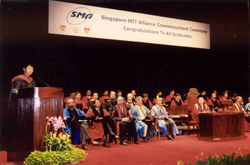 The
editorial team is very grateful to Mr. David Matius Gomulya, a graduate
of the IMST Programme, for his permission to publish his valedictory speech
delivered during the SMA Commencement Ceremony 2001. Below is a copy of
his speech in its entirety.
The
editorial team is very grateful to Mr. David Matius Gomulya, a graduate
of the IMST Programme, for his permission to publish his valedictory speech
delivered during the SMA Commencement Ceremony 2001. Below is a copy of
his speech in its entirety.
"Dear Mr. Pro-Chancellors, Vice-Chancellor NUS, President NTU, Distinguished Guests, Fellow Graduates, Ladies and Gentlemen,
I would like to express my deepest gratitude for the trust that has been given me to represent this elite cohort of SMA students.
One great year has passed and we all are about to formally conclude this important chapter of our lives and commence a new one. I cannot find a better way of starting this valedictory speech than by thanking all the people without whom we could not have made it this far.
First of all to our families and loved ones who have given their blessings and support throughout the exciting times in our study. It is crystal clear that without their encouragement, it would have been very difficult to begin this course, not to mention completing it. At this moment, we want very much to thank all of them from the bottom of our hearts.
If you look in front of you on this very stage, it is very obvious to see the people who have made this programme possible. Words cannot seem to express completely our gratitude to our Professors, but we know deep down how grateful we are for the time and effort they have put into the course, especially when we consider the seemingly odd timing for lectures that we have. We believe that they share with us more than just technical knowledge. They are driven beyond what their vocation requires them to do.
We should also not forget all the administrative staff, who had helped in planning many of the very important schedules of this course. There always seem to be the last-minute requests from us, which they entertained, and bearing with us the occasional pranks that we have played throughout the year. Needless to say, we appreciate them deeply and are very grateful for their help.
At this point, we would also like to thank our Alma Mater. Without the foundations that they have laid in developing us, it would have been quite difficult to meet the challenges faced in this programme.
Many great memories have surely been imprinted in our minds for the past year; All the ups and downs of our SMA's life, the exams, the very early lectures and the very late lectures as well, the fun and laughter during gatherings, the inter-programme games and birthday celebrations.
We have obtained our Master's from this elite Alliance, and so, what is next? There are a few thoughts that crossed my mind and I would like to share them with you.
We will take different paths from this point onwards all eventually leading to success.
Though success itself is difficult to measure, perhaps we may want to consider three factors leading to it.
Connection I believe if we maintain good contact among ourselves, the Alumni, throughout the years, we would have been successful in a sense. One of the many objectives of this course is to build a strong network of people who think globally. The importance of the word "network" cannot be over emphasized. If we can overcome the geographical barriers and the demands of our hectic lives, I believe the programme would have achieved one successful result.
Personal development The programme has developed the potential in us. However, the programme can only do so much and most of our personal development depends on ourselves. Developing ourselves to the fullest could be another important attribute of success.
Contribution to society Needless to say, contribution to the society is another good measure of success. I hope that we will always bear in mind, despite the many temptations that we may face later on in life, that human knowledge should belong to the world. And it is sad if the knowledge and experiences that we have accumulated are not shared with others.
So, to conclude, I hope in our first reunion, whenever it might be, we can measure ourselves against these ideals and be able to say we have made it.
I would like to end this speech by asking my fellow students to rise and give a big round of applause to all who have made us what we are today, to this great occasion and also to ourselves. With that I thank you all."
Mr. David Matius Gomulya
Valedictorian, 2000--2001
By Ma Nang Laik
Sreekumar |
I am working as a decision support analyst in iFusion Singapore, where we provide supply chain solutions to companies involved in warehousing, logistics and manufacturing activities. The SMA HPCES programme did a great job in instilling in me the confidence to work in iFusion by providing me with a strong academic background, analysis skill and problem solving skill. The hands-on approach of exposing us to solving real world problem is one of the things that make the SMA program unique. With the knowledge and skill that I have acquired from SMA and my working experiences, I hope to be an entrepreneur within the next 10 years. |
Wee Hock Guan |
I have been working as a technical account manager in ILOG, Singapore. The SMA HPCES programme has helped me tremendously in providing me a strong fundamental background in the operations research area. The course did not only focus on the fundamental theory of operations research but gave us many hands-on experience which relates theories to applications, helping us analyze, model and solve real world optimization problem. |
Tee ChinWee |
For the past 1 year, I have been working in Defense Science and Technology Agency (DSTA) as a Business Analyst. In the mean time, I am holding the concurrent appointment of Technology Leader in the one of the technology domains managed by my Division. The optimization course in SMA has allowed me to add value to the overall solution by integrating optimization techniques to solve many of the users' decision-making applications. |
Balagopal Kunduvara |
I have been working with Singapore Airlines Technical Services since June 2000. The job involves maintenance of aircraft engines as well as development of long-term plans for the fleet. The SMA course does not figure directly in my current work scope but I have found it useful in discussing engineering problems with and proposing solutions to engine designers and manufacturers. |
Sameer Ansar |
I am working as a Failure Analysis Engineer at Chartered Semiconductor Manufacturing. My job scope involves testing the devices after production in the foundry to ensure quality products so as to build trusted long-term customer relationships. The SMA course gave me the confidence to excel in my work by providing me with a strong understanding of the Semiconductor industry and IC processes. |
Kelvin Teo |
I have been working as an Applications Development Engineer at 3M St. Paul on 3M Slurry-Free CMP abrasives. SMA has given a strong fundamental background in understanding IC processes. 3M is an established company with divisions involved in R&D, electronics packaging, gases and Wafer polishing. |
Tan Boon Kiat |
I have been working with SSMC (Systems on Silicon Manufacturing Co. Pte Ltd.) since August last year. My company is in the wafer foundry business where we manufacture chips on wafers. My primary role is to transfer technology from Taiwan and qualify them in SSMC before release to Manufacturing. The kind of training and course materials that I was provided with in SMA is unparalleled and I greatly believe that getting an education from MIT is like taking a drink from the fire hose. However the vast amount of network and training that I've gathered from MIT, NUS and NTU is one of the best assets that I had gained in the 1 year with SMA. |
By Shirley Meng Ying
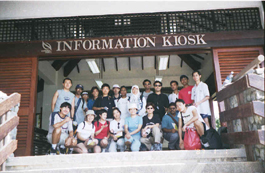 Pulau
Ubin Island Hiking/Biking:
Pulau
Ubin Island Hiking/Biking:
About thirty SMA students and Alumni Club members visited the small tropical island - with tropical rain forest and beautiful sea views. This gathering left every participant with cherished memories.
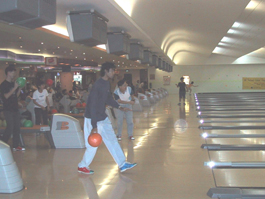 Sports
games:
Sports
games:
"All work and no play make Jack a dull boy." We work hard, and we play hard. The competitions in the sports games enhanced the friendships among current batch students and alumni members.
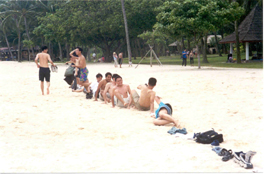 Sentosa
2001:
Sentosa
2001:
At Sentosa, SMA Classes of 2001, 2000 and 1999 gathered and had a wonderful time near the beautiful beach there. Fun and games including beach volleyball was followed by a barbeque dinner. About 80 SMA alumni members and current students participated in this unforgettable event.
By Adam Mersereau
Greetings SMA alumni! Twelve fellow MIT graduate students and I were fortunate to visit Singapore January 15-19 as part of the SMA Symposium. It was our pleasure to meet many of you while we were there. For all of us (except for Melvyn Sim), it was our first visit to Singapore, and we had a wonderful trip, thanks in large part to the generous hospitality of the SMA alumni and current SMA students.
The first thing we learned is that it takes a long time to get from Boston to Singapore. After some long flights and a long sleep, we were ready to begin our visit in earnest. During the first three days of our visit, we spent most of our time participating in the Symposium at NUS. The main program of the SMA symposium was on Tuesday and included remarks by the program directors. The afternoon session featured talks by MIT and Singapore professors, as well as some recent SMA alumni. Special thanks to Teo Kwong Meng, Rajeeva Krishna Moorthi, and our own friend Melvyn Sim for their very interesting talks.
Monday and Wednesday featured talks by current SMA and MIT students and SMA research associates. It was interesting to learn about the wide range of projects inspired by the SMA program. Thanks to all who spoke and who listened attentively to the other MIT students and me.
In addition to the symposium, a highlight of our time in Singapore was the fabulous city tour organized by the SMA alumni association. On Friday afternoon, Franklin Tan, Shidrati Ali, and Ma Nang Laik led a bus full of MIT faculty, MIT students, and SMA students on an extensive tour of the city. As we drove around Singapore, our knowledgeable hosts narrated the trip with relevant historical background and provided cultural context for many of the things we saw. It was clear they had done their homework.
Our first stop was in Little India, where we viewed the Sikh Temple and the Sri Veeramakaliamman Temple. Next we went to Chinatown, where we experienced the bustle of the street markets in preparation for the Chinese New Year, as well as a true Singapore rainstorm. We are grateful to our tour guides, who braved the rain to buy umbrellas for everyone on the bus! Umbrellas in hand, we left the bus and shopped for an hour in the maze of markets. Only a little bit wet, we re-boarded the bus and proceeded to the final stop of our tour, the food court at the Lau Pa Sat Festival Center. We sampled some excellent Singaporean food, from chicken rice to pepper crabs. At the end of the tour, our hosts wished us Happy New Year and presented us with delicious mandarin oranges.
Through organized and informal activities alike, SMA students and alumni generously offered their time by taking us out for dinners at the Jurong Mall food court and the Zam-Zam Restaurant in Little India, bringing us to Sentosa, taking us bowling and ice skating, and even feeding us durians. (Thanks personally to Alvin for a round of drinks on Orchard Road, to Franklin for the bowling tips, to Sid for showing us the inside of a mosque, and to Nang Laik for buying us coconuts to wash away the durian taste!) We will remember these special moments for a long time. Thanks for everything, and we hope to see you again soon.
By For Chee Wei
Filled with excitement, we set off to Boston for our Immersion Program on the 24th July 2001, many of us with plans to explore Boston and of course, to visit and study in the world renown university of MIT. We arrived in Boston after 24 hrs of flight; many of us drained, and we could not wait to settle down in our hostel after sleepless hours on the plane. As the MIT hostel was under renovation, we were, unlike the senior batch, arranged to stay in the Boston University hostel, Warren Heights, for the whole of our Immersion Program.
The first week of the program was spent attending talks by successful individuals,
who shared their experiences in doing their own startup companies with us.
Though most of us have never ventured into any kind of business, these experiences
have undoubtedly spurred many of our young hearts to be innovative, persistent
in attaining our goals, and not giving up easily when encountered with any
kind of failures.

MIT Building
Intensive lectures and lab sessions on linear algebra by Professor Gilbert Strang and Professor Jacob White were arranged for us, the HPCES students, for the next two weeks. Having learnt linear algebra for a semester in my undergraduate days, I thought that these two weeks would be easy and comfortable for me. However, Professor Gilbert Strang gave us some new perspectives in linear algebra in the sense that linear algebra is not simply the mathematical calculation of ranks or eigenvalues and eigenvectors that I had learnt, but the understanding of what these terms actually are and their applications. I was deeply impressed by his love for mathematics and what we have learnt would indeed be a useful tool for our future studies and work.
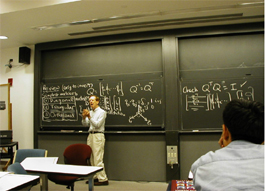
Prof Gilbert Strang giving lecture
The lab sessions conducted by Professor Jacob White were designed to enhance what we have learnt in the lectures. Through seemingly "simple" questions, we had the opportunity to apply what we have learnt in the lectures and that enhanced our understanding of linear algebra.

The whole class with Prof Jacob White
Another activity planned for us was the National Day celebration. As most of us have never spent our National Day abroad, we had never expected that the National Day would mean so much to us. The national anthem was played and we have never missed our country, family and friends in Singapore that much since the first day we arrived in Boston. Despite of our homesickness, we enjoyed the karaoke session and Penang food catered for us, especially after so many meals of burgers and fries.
We had all the time to ourselves in the weekends. There are the adventurous groups who traveled to New York and the Niagara Fall. As for me, I decided to stay around and explore Boston instead. Some of my classmates and I went for whale watching, where we had a close encounter with the largest mammal on earth, beaches such as the Wonderland, duck tour which introduced us to parts of Boston, freedom trail and many others. A place worth mentioning is Cape Cod where the large population of gays was indeed an eye opener for us. Of course, we did not miss out on the lobster and seafood in Boston. The cheapest lobster we found was the lobster sandwich in McDonalds's, as Boston is the only state with McDonalds's selling lobster sandwich.

Whale Watching
The immersion program lasted for three weeks and was an unforgettable and fruitful experience for us. We have learnt a lot and played hard as well. The lessons learnt and knowledge acquired will undoubtedly come in use in our lives in future.
Franklin Tan
Shirley Meng
Samer Ansari
Helen Chuwardi
Low Sok Chay
Ma Nang Laik
Shidrati Ali
Tee Chin Wee
Wu Fang
Yang Changjun